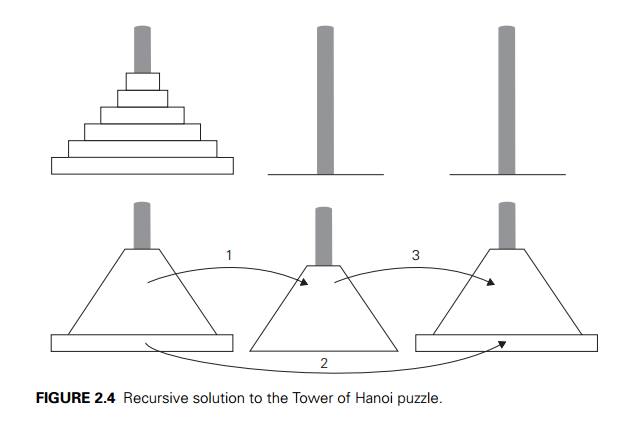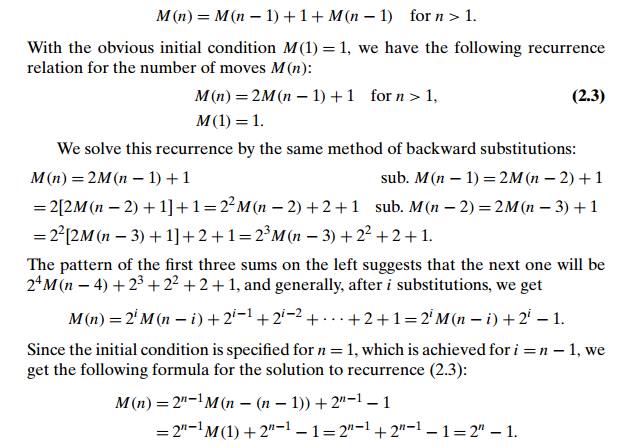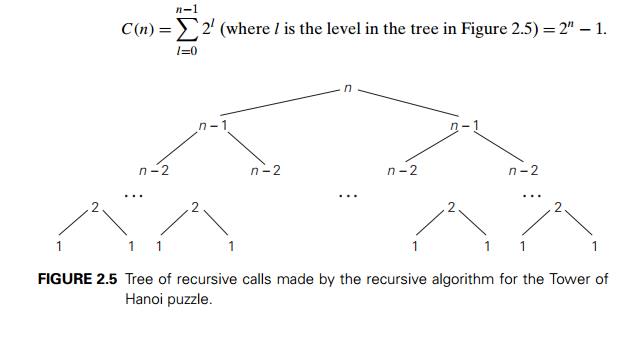Chapter: Introduction to the Design and Analysis of Algorithms : Fundamentals of the Analysis of Algorithm Efficiency
Mathematical Analysis of Recursive Algorithms
Mathematical
Analysis of Recursive Algorithms
In this
section, we will see how to apply the general framework for analysis of
algorithms to recursive algorithms. We start with an example often used to
introduce novices to the idea of a recursive algorithm.
EXAMPLE 1 Compute
the factorial function F (n)
= n! for an arbitrary nonneg-ative
integer n. Since
n!
= 1
. . . . . (n − 1) . n = (n − 1)!
. n for
n ≥ 1
and 0! = 1 by definition, we can compute F (n) = F (n − 1) . n with the following recursive
algorithm.
ALGORITHM F(n)
//Computes
n! recursively //Input: A nonnegative
integer n //Output: The value of n!
if n = 0 return 1
else return F
(n − 1) ∗ n
For
simplicity, we consider n itself
as an indicator of this algorithm’s input size (rather than the number of bits
in its binary expansion). The basic operation of the algorithm is
multiplication,5 whose number of executions we denote M(n). Since the function F (n) is computed according to the
formula
F (n) = F (n − 1)
. n for
n > 0,
the
number of multiplications M(n) needed
to compute it must satisfy the equality

Indeed, M(n − 1) multiplications are spent to
compute F (n − 1), and one more multiplication is
needed to multiply the result by n.
The last
equation defines the sequence M(n) that we
need to find. This equa-tion defines M(n) not
explicitly, i.e., as a function of n, but
implicitly as a function of its value at another point, namely n − 1. Such equations are called recurrence
relations
or, for brevity, recurrences. Recurrence relations
play an important role not only in analysis of algorithms
but also in some areas of applied mathematics. They are usually studied in
detail in courses on discrete mathematics or discrete structures; a very brief
tutorial on them is provided in Appendix B. Our goal now is to solve the
recurrence relation M(n) = M(n − 1) + 1, i.e., to find an explicit
formula for M(n) in terms of n only.
Note,
however, that there is not one but infinitely many sequences that satisfy this
recurrence. (Can you give examples of, say, two of them?) To determine a
solution uniquely, we need an initial condition that tells us the
value with which the sequence starts. We can obtain this value by inspecting
the condition that makes the algorithm stop its recursive calls:
if n = 0 return 1.
This
tells us two things. First, since the calls stop when n = 0, the smallest value of n for which this algorithm is
executed and hence M(n) defined
is 0. Second, by inspecting the pseudocode’s exiting line, we can see that when
n = 0, the algorithm performs no
multiplications. Therefore, the initial condition we are after is

Before we
embark on a discussion of how to solve this recurrence, let us pause to
reiterate an important point. We are dealing here with two recursively defined
functions. The first is the factorial function F
(n) itself; it is defined by the recurrence

The
second is the number of multiplications M(n) needed
to compute F (n) by the recursive algorithm whose
pseudocode was given at the beginning of the section.
As we
just showed, M(n) is defined by recurrence (2.2).
And it is recurrence (2.2) that we need to solve now.
Though it
is not difficult to “guess” the solution here (what sequence starts with 0 when
n = 0 and
increases by 1 on each step?), it will be more useful to arrive at it in a
systematic fashion. From the several techniques available for solving
recurrence relations, we use what can be called the method of backward substitutions.
The method’s idea (and the reason for the name) is immediately clear
from the way it applies to solving our particular recurrence:

After
inspecting the first three lines, we see an emerging pattern, which makes it
possible to predict not only the next line (what would it be?) but also a
general formula for the pattern: M(n) = M(n − i) + i. Strictly
speaking, the correctness of this formula should be proved by mathematical
induction, but it is easier to get to the solution as follows and then verify
its correctness.
What
remains to be done is to take advantage of the initial condition given. Since
it is specified for n = 0, we have
to substitute i = n in the
pattern’s formula to get the ultimate result of our backward substitutions:

You
should not be disappointed after exerting so much effort to get this “obvious”
answer. The benefits of the method illustrated in this simple example will
become clear very soon, when we have to solve more difficult recurrences. Also,
note that the simple iterative algorithm that accumulates the product of n consecutive integers requires
the same number of multiplications, and it does so without the overhead of time
and space used for maintaining the recursion’s stack.
The issue
of time efficiency is actually not that important for the problem of computing n!, however. As we saw in Section
2.1, the function’s values get so large so fast that we can realistically
compute exact values of n! only
for very small n’s. Again, we use this example just
as a simple and convenient vehicle to introduce the standard approach to
analyzing recursive algorithms.
Generalizing
our experience with investigating the recursive algorithm for computing n!, we can now outline a general
plan for investigating recursive algo-rithms.
General
Plan for Analyzing the Time Efficiency of Recursive Algorithms
Identify the algorithm’s basic operation.
Check whether the number of times the basic operation is executed can vary on different inputs of the same size; if it can, the worst-case, average-case, and best-case efficiencies must be investigated separately.
Set up a recurrence relation, with an appropriate initial condition, for the number of times the basic operation is executed.
Solve the recurrence or, at least, ascertain the order of growth of its solution.
EXAMPLE 2 As our
next example, we consider another educational workhorse of
recursive algorithms: the Tower of Hanoi puzzle. In this
puzzle, we (or mythical monks, if you do not like to move disks) have n disks of different sizes that
can slide onto any of three pegs. Initially, all the disks are on the first peg
in order of size, the largest on the bottom and the smallest on top. The goal
is to move all the disks to the third peg, using the second one as an
auxiliary, if necessary. We can move only one disk at a time, and it is
forbidden to place a larger disk on top of a smaller one.
The
problem has an elegant recursive solution, which is illustrated in Fig-ure 2.4.
To move n > 1 disks from peg 1 to peg 3
(with peg 2 as auxiliary), we first move recursively n − 1 disks
from peg 1 to peg 2 (with peg 3 as auxiliary), then move the largest disk
directly from peg 1 to peg 3, and, finally, move recursively n − 1 disks
from peg 2 to peg 3 (using peg 1 as auxiliary). Of course, if n = 1, we
simply
move the single disk directly from the source peg to the destination peg.

Let us
apply the general plan outlined above to the Tower of Hanoi problem. The number
of disks n is the obvious choice for the
input’s size indicator, and so is moving one disk as the algorithm’s basic
operation. Clearly, the number of moves M(n)
depends
on n only, and we get the following
recurrence equation for it:

Thus, we
have an exponential algorithm, which will run for an unimaginably long time
even for moderate values of n (see
Problem 5 in this section’s exercises). This is not due to the fact that this
particular algorithm is poor; in fact, it is not difficult to prove that this
is the most efficient algorithm possible for this problem. It is the problem’s
intrinsic difficulty that makes it so computationally hard. Still, this example
makes an important general point:
One
should be careful with recursive algorithms because their succinctness may mask
their inefficiency.
When a
recursive algorithm makes more than a single call to itself, it can be useful
for analysis purposes to construct a tree of its recursive calls. In this tree,
nodes correspond to recursive calls, and we can label them with the value of
the parameter (or, more generally, parameters) of the calls. For the Tower of
Hanoi example, the tree is given in Figure 2.5. By counting the number of nodes
in the tree, we can get the total number of calls made by the Tower of Hanoi
algorithm:

The
number agrees, as it should, with the move count obtained earlier.
EXAMPLE 3 As our
next example, we investigate a recursive version of the algorithm
discussed at the end of Section 2.3.
ALGORITHM BinRec(n)
//Input:
A positive decimal integer n
//Output:
The number of binary digits in n’s binary
representation if n = 1 return 1
else return BinRec( n/2 ) + 1
Let us
set up a recurrence and an initial condition for the number of addi-tions A(n) made by the algorithm. The
number of additions made in computing BinRec( n/2 ) is A(
n/2 ), plus
one more addition is made by the algorithm to increase the returned value by 1. This leads to the recurrence

Since the
recursive calls end when n is equal
to 1 and there are no additions made then, the initial condition is

The
presence of n/2 in the function’s argument
makes the method of back-ward substitutions stumble on values of n that are not powers of 2.
Therefore, the standard approach to solving such a recurrence is to solve it
only for n = 2k and then take advantage of the
theorem called the smoothness rule (see Appendix B), which claims that under very
broad assumptions the order of growth observed for n
= 2k gives a correct answer about the
order of growth for all values of n. (Alter-natively,
after getting a solution for powers of 2, we can sometimes fine-tune this
solution to get a formula valid for an arbitrary n.) So let
us apply this recipe to our recurrence, which for n = 2k takes
the form

Thus, we
end up with
A(2k) = A(1) + k = k,
or, after
returning to the original variable n = 2k and
hence k = log2
n,
A(n) = log2 n ∈ (log n).
In fact,
one can prove (Problem 7 in this section’s exercises) that the exact solution
for an arbitrary value of n is given
by just a slightly more refined formula A(n) = log2 n
This
section provides an introduction to the analysis of recursive algorithms. These
techniques will be used throughout the book and expanded further as necessary.
In the next section, we discuss the Fibonacci numbers; their analysis involves
more difficult recurrence relations to be solved by a method different from
backward substitutions.
Exercises 2.4
1. Solve the following recurrence
relations.
a. x(n) = x(n − 1) + 5 for n
> 1, x(1)
= 0
b. x(n) = 3x(n − 1) for n > 1, x(1)
= 4
c. x(n) = x(n − 1) + n for n
> 0, x(0)
= 0
d. x(n) = x(n/2) + n for n
> 1, x(1)
= 1 (solve for n = 2k)
e. x(n) = x(n/3) + 1 for n > 1, x(1)
= 1 (solve for n = 3k)
Set up
and solve a recurrence relation for the number of calls made by F (n), the recursive algorithm for
computing n!.
Consider
the following recursive algorithm for computing the sum of the first n cubes:
S(n) = 13 + 23 + .
. . + n3.
ALGORITHM S(n)
//Input:
A positive integer n
//Output:
The sum of the first n cubes if n = 1 return 1
else return S(n − 1) + n ∗ n ∗ n
Set up and solve a recurrence relation for the
number of times the algo-rithm’s basic operation is executed.
How does this algorithm compare with the
straightforward nonrecursive algorithm for computing this sum?
Consider the following recursive algorithm.
ALGORITHM Q(n)
//Input:
A positive integer n if n = 1 return 1
else return Q(n − 1) + 2 ∗ n − 1
Set up a recurrence relation for this function’s values and solve it to deter-mine what this algorithm computes.
Set up a recurrence relation for the number of multiplications made by this algorithm and solve it.
Set up a recurrence relation for the number of additions/subtractions made by this algorithm and solve it.
In
the original version of the Tower of Hanoi puzzle, as it was published in the
1890s by Edouard Lucas, a French mathematician, the world will end after 64
disks have been moved from a mystical Tower of Brahma. Estimate the number of
years it will take if monks could move one disk per minute. (Assume that monks
do not eat, sleep, or die.)
How
many moves are made by the ith largest disk (1 ≤ i ≤ n) in this algorithm?
Find
a nonrecursive algorithm for the Tower of Hanoi puzzle and imple-ment it in the
language of your choice.
Restricted
Tower of Hanoi Consider the version of the Tower of Hanoi puzzle in which n
disks have to be moved from peg A to peg C using peg B so that any move should
either place a disk on peg B or move a disk from that peg. (Of course, the
prohibition of placing a larger disk on top of a smaller one remains in place,
too.) Design a recursive algorithm for this problem and find the number of
moves made by it.
a.
Prove that the exact number of additions made by the recursive algorithm
BinRec(n) for an arbitrary positive decimal integer n is log2 n .
Set
up a recurrence relation for the number of additions made by the nonrecursive
version of this algorithm (see Section 2.3, Example 4) and solve it.
a.
Design a recursive algorithm for computing 2n for any nonnegative integer n
that is based on the formula 2n = 2n−1 + 2n−1.
Set
up a recurrence relation for the number of additions made by the algorithm and
solve it.
Draw
a tree of recursive calls for this algorithm and count the number of calls made
by the algorithm.
Is
it a good algorithm for solving this problem?
Consider
the following recursive algorithm.
//Input:
An array A[0..n − 1] of real numbers if n = 1 return A[0]
else temp ← Riddle(A[0..n − 2]) if temp ≤ A[n − 1] return temp
else return A[n − 1]
What does
this algorithm compute?
Set up a
recurrence relation for the algorithm’s basic operation count and solve it.
Consider
the following algorithm to check whether a graph defined by its adjacency
matrix is complete.
ALGORITHM GraphComplete(A[0..n − 1, 0..n − 1])
//Input:
Adjacency matrix A[0..n − 1, 0..n − 1]) of an
undirected graph G
//Output: 1 (true) if G is
complete and 0 (false) otherwise
if n = 1 return 1 //one-vertex
graph is complete by definition
else
if not GraphComplete(A[0..n − 2, 0..n − 2]) return 0 else for j ← 0 to n − 2 do
if A[n − 1, j ] = 0 return 0 return 1
What is
the algorithm’s efficiency class in the worst case?
11. The determinant of an n × n matrix

where sj is +1 if
j is even and −1 if j is odd, a0 j is the element in row 0 and
column j , and Aj is the (n − 1) × (n − 1) matrix obtained from matrix A by deleting its row 0 and column
j .
Set up a recurrence relation for the number of
multiplications made by the algorithm implementing this recursive definition.
Without solving the recurrence, what can you say
about the solution’s order of growth as compared to n!?
12. von Neumann’s neighborhood revisited Find
the number of cells in the von Neumann
neighborhood of range n (Problem
12 in Exercises 2.3) by setting up and solving
a recurrence relation.
Frying
hamburgers There are n hamburgers
to be fried on a small grill that can
hold only two hamburgers at a time. Each hamburger has to be fried on both
sides; frying one side of a hamburger takes 1 minute, regardless of whether one
or two hamburgers are fried at the same time. Consider the following recursive
algorithm for executing this task in the minimum amount of time. If n ≤ 2, fry the hamburger or the two
hamburgers together on each side. If n
> 2, fry any two hamburgers together
on each side and then apply the same procedure recursively to the remaining n − 2
hamburgers.
Set up and solve the recurrence for the amount of
time this algorithm needs to fry n
hamburgers.
Explain why this algorithm does not fry the hamburgers in the minimum
amount of time for all n > 0.
Give a correct recursive algorithm that executes
the task in the minimum amount of time.
Celebrity problem A
celebrity among a group of n people is
a person who knows nobody but is
known by everybody else. The task is to identify a celebrity by only asking
questions to people of the form “Do you know him/her?” Design an efficient
algorithm to identify a celebrity or determine that the group has no such
person. How many questions does your algorithm need in the worst case?
Related Topics